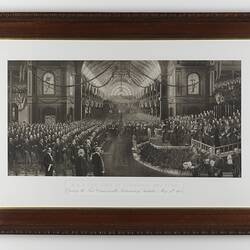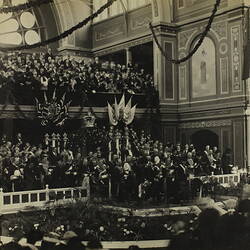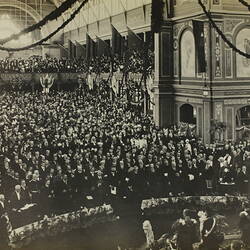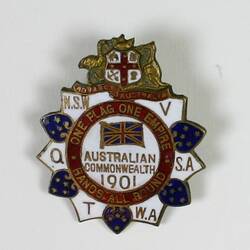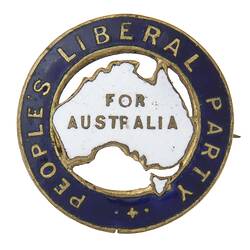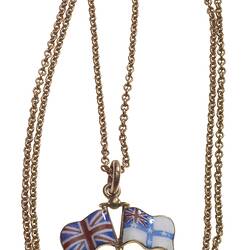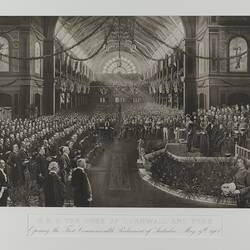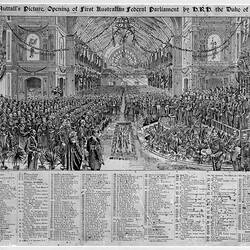Summary
The Commonwealth of Australia was inaugurated on 1st January 1901 in Centennial Park, Sydney. In March, elections were held for the new Federal Parliament, and in May the celebrations focused on Melbourne, where the first Federal Parliament was opened in the (Royal) Exhibition Building. The opening event was captured by two contemporary artists, as is explained in this narrative.
'The atmosphere was radiant and illuminated the vast spaces of the building and the great sea of faces with a bright Australian glow. A sight never to be forgotten was the assemblage which, in perfect order but with exalted feeling, awaited the arrival of the Duke and Duchess in the great avenues which branch out from beneath the vast dome of the Exhibition Building.' (Argus 10 May 1901)
The opening of the first Federal Parliament
On 9 May 1901 the Royal Exhibition Building hosted the opening of the first Federal Parliament. Prime Minister Barton wanted it to be as inclusive as possible. No other public building could accommodate such a large group of people, and the organisers were eager to make the occasion spectacular and memorable. The Duke and Duchess of Cornwall and York visited Melbourne for the event, creating great excitement as they attended receptions, processions and other functions held in their honour. Melbourne's streets and buildings were elaborately decorated, and people from all over Australia visited for the celebrations surrounding the opening.
The Duke and the Governor-General, Lord Hopetoun, read speeches and prayers, including a message from the King, and then the federal parliamentarians were sworn in, before an audience of 12 000 dignitaries and their families. After the long process of negotiation, drafting the constitution and referendums leading up to Federation, the Commonwealth of Australia now had an elected federal government.
A record of the historic event
The importance of the opening of Federal Parliament required a significant visual record of the event, and a group of businessmen commissioned Charles Nuttall to produce a large painting depicting as many of the dignitaries as possible. Another group asked Tom Roberts to do a painting. Both artists painted large paintings, but in a very different style. Charles Nuttall's painting aims for clarity, while Tom Roberts' painting is more evocative and impressionistic.
Both painters used some artistic licence in their depictions of the event. The dais and steps depicted in Robert's painting do not resemble the actual dais and steps. Nuttall arranged the parliamentarians in curved rather than straight rows in order to include more faces, substituted spiky palms for massed chrysanthemums around the dais, and included George Reid (a former NSW premier and future Prime Minister) who missed the event due to illness. Both artists aimed to create a moment of mythical importance to Australian history in their depictions. They chose the moment the sun burst through the clouds and cast a beam of light onto the scene.
Tom Roberts' painting now belongs to Queen Elizabeth II, but is on loan to Parliament House in Canberra. The Charles Nuttall painting is in the collection of Museum Victoria.
Charles Nuttall's The Opening of Federal Parliament, 9 May 1901
Charles Nuttall was born in the inner-Melbourne suburb of Fitzroy, in 1872, and was a well-known illustrator and cartoonist, whose work appeared in books, postcards and publications such as the Bulletin. He began work on The Opening of Federal Parliament on 19 August 1901, setting up a studio in the Exhibition Building. He commented in 1905, 'It was a somewhat fearsome work, involving endless trouble, a tremendous amount of labour, and a great deal of running about'. In his large painting, almost 4 by 2.3 metres, he sought to communicate the grand scale of the event. The painting has an unusual sepia tone, partly adopted by Nuttall due to his colour-blindness.
Following his brief to represent as many 'heads' as possible, among the vast crowd he included 344 recognisable portraits of local and international dignitaries. To achieve this, he had to organise sittings of the various subjects so that he could make sketches. He said of these sittings: 'Posing ... is not as easy as it looks. It is largely a matter of nerves and effects people in different ways. Mr Barton [the Prime Minister] was restless and irritable but finally settled down and sat well; Mr Reid promptly went to sleep, and only consented to sit seriously when I threatened to publish a sketch I made during his nap.'
In 1905 Nuttall travelled to America, where he worked as a staff artist for the New York Times and contributed to other publications. He returned in 1910 and continued to paint and draw, as well as write for books and magazines.
Fame, neglect and restoration
Reproductions of Charles Nuttall's painting in photogravure (the largest ones then on record) were made by Goupil et Cie in France. In the first half of the twentieth-century the Nuttall was the painting that was well known throughout Australia as representing Federation. Reproductions were sold with the slogan 'No Australian Home will be complete without a Copy'. For the next fifty years the painting was the predominant image of Federation, hanging in many homes, public buildings, schools and libraries.
It was expected that the painting would hang in the main hall of the Federal Parliament but it returned to the Exhibition Building. Unfortunately the painting was somehow forgotten and neglected in the basement and became extensively damaged by damp. In the early 1980s, conservator Amam Siddique and his team spent two years restoring the painting. The photogravure's provided valuable information for the repainting of missing sections.
More Information
-
Keywords
-
Authors
-
Article types


